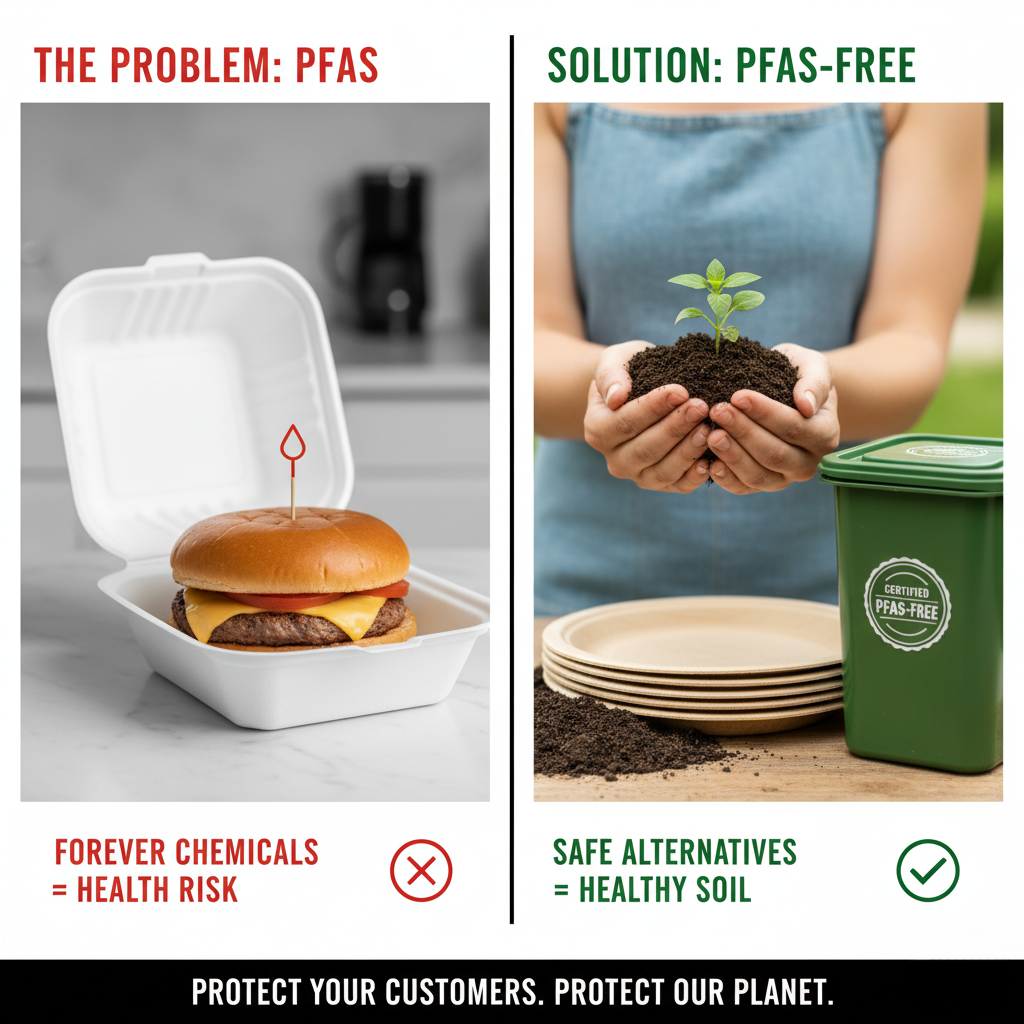
The Definitive Guide to PFAS-Free Food Packaging
Share
The world of food packaging is undergoing a massive shift. As consumers and regulators become increasingly aware of the health and environmental hazards posed by Per- and Polyfluoroalkyl Substances (PFAS), transitioning to PFAS-free food packaging is no longer optional—it's essential for compliance, brand reputation, and public safety.
This guide breaks down what PFAS are, why they are problematic in food service, and, most importantly, how to navigate the alternatives to ensure your packaging is safe, effective, and compliant.
1. Understanding the Problem: What Are PFAS?
PFAS are a large class of over 10,000 synthetic chemicals that have been used globally since the 1940s. They are known as "forever chemicals" because their strong carbon-fluorine bonds make them extremely persistent, meaning they do not break down easily in the environment or the human body.
Why Are They in Food Packaging?
PFAS are prized for their unique properties:
- Oil and Grease Repellency: They create an effective barrier that prevents fats and oils from soaking through paper and molded fiber containers.
- Water and Stain Resistance: They make surfaces non-stick and highly resistant to moisture.
These properties made them common in disposable products like:
- Molded fiber bowls and clamshells (especially those used for hot, greasy foods)
- Grease-proof paper (e.g., fast-food wrappers, bakery bags)
- Microwave popcorn bags and butter wrappers
The Health and Environmental Hazards
PFAS can migrate from packaging into the food itself, leading to human consumption. Exposure to certain PFAS has been linked to:
- Increased cholesterol levels
- Immune system harm (e.g., decreased vaccine response)
- Thyroid disease
- Developmental effects in children
- Certain cancers
When disposed of, PFAS contaminate water, soil, and even compost, re-entering the food system and accumulating over time.
2. The Regulatory Landscape: Going PFAS-Free is the Baseline
State, federal, and international regulations are rapidly banning the intentional use of PFAS in food packaging, particularly in fiber-based items.
Key Regulatory Trends:
- State Bans (US): States like California, New York, Washington, Minnesota, and others have enacted laws prohibiting intentionally added PFAS in food packaging, often using a "Total Organic Fluorine" (TOF) screen (e.g., less than 100 parts per million) as a proxy for compliance.
- Federal Action (US FDA): The U.S. FDA announced in early 2024 that manufacturers have voluntarily ceased the sale of PFAS-based grease-proofing agents for paper/paperboard food packaging in the US market, effectively eliminating a major source of dietary exposure.
- Global Phase-Outs: The European Union and countries like Australia are implementing sweeping rules to phase out or ban key PFAS chemicals (like PFOA, PFOS, and PFHxS) in articles, including food packaging, often aligning with international treaties.
The practical takeaway for businesses: If you use disposable, fiber-based packaging (paper, paperboard, bagasse/molded fiber), you must assume that intentionally added PFAS are banned or will be soon, regardless of your location.
3. The Solution: Safe, High-Performing PFAS-Free Alternatives
The good news is that viable, high-performing alternatives exist across several material categories. When seeking a PFAS-free solution, you are primarily looking for alternative coatings or materials that provide the necessary grease and moisture barrier.
| Packaging Type | PFAS-Free Alternatives | Key Benefits |
| Molded Fiber (Plates, Clamshells) | Bagasse (Sugarcane Fiber) with natural, clay, or proprietary PLA/bio-wax coatings. | Excellent compostability; uses agricultural waste; effective grease barrier when coated correctly. |
| Wraps and Liners | Bio-Wax Coatings: Natural, food-grade wax blends. Natural Greaseproof Paper: Mechanically refined paper without chemical coatings. | Good moisture and grease resistance; often recyclable or compostable depending on the wax. |
| Bowls and Containers | PLA-Lined Paperboard: Paperboard coated with Polylactic Acid (a plant-based compostable plastic). Uncoated/Clay-Coated Paperboard | High structural integrity; PLA provides excellent liquid barrier; clay offers a mineral-based grease barrier. |
| Cutlery | Wood/Bamboo: Simply polished natural wood or bamboo. PLA/CPLA: Plant-based compostable plastic. | Wood is naturally PFAS-free; CPLA is heat-resistant and certified compostable. |
Important Note on Composability: Many of these alternatives (especially those coated with PLA or proprietary barrier chemicals) require commercial composting to break down fully. Ensure your choice aligns with your disposal goals.
4. How to Verify and Purchase PFAS-Free Packaging
To confidently source packaging that is both safe and compliant, follow these steps:
A. Demand Transparency from Suppliers
- Request Attestation: Require your suppliers to provide a signed statement or written guarantee that the food contact materials contain no intentionally added PFAS.
- Ask for Test Results (Total Fluorine): The gold standard for verification is third-party lab testing. Ask for test results showing that the product meets the total organic fluorine (TOF) threshold, typically 100 ppm or less. This tests for the entire class of fluorinated chemicals, including unknown contaminants.
B. Look for Third-Party Certifications
Reputable certification bodies have stringent standards that specifically screen for PFAS:
| Certification | Focus | Requirement for PFAS |
| BPI Certified Compostable | Products designed to break down in industrial composting facilities. | Requires testing for total fluorine (TOF) to be under 100 ppm to achieve certification. |
| GreenScreen Certified | Products screened for specific hazardous chemicals. | Products certified as PFAS-Free are explicitly verified as containing no intentionally added PFAS. |
| Cradle to Cradle Certified | Holistic assessment of material health and sustainability. | Higher levels (Silver/Gold/Platinum) restrict chemicals of concern, including PFAS. |
C. Prioritize Reusable Solutions
The ultimate PFAS-free solution is reducing reliance on single-use disposables entirely. If feasible, transition to durable, reusable food service ware for on-site dining or implement a customer-based reusable takeout program.
Conclusion: The Future is Fluorine-Free
The phase-out of PFAS marks a significant victory for public health and environmental integrity. By understanding the true nature of these "forever chemicals" and committing to verified, third-party certified PFAS-free alternatives—especially innovative materials like responsibly sourced bagasse and natural coatings—businesses can lead the way toward a safer, cleaner, and fully compliant food service industry.
